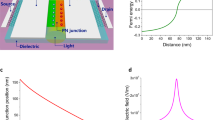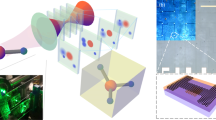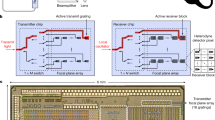Abstract
The core of any optical imaging system is a photodetector. Whether it is film or a semiconductor chip in a camera, or indeed the retina in an eye, conventional photodetectors are designed to absorb most of the incident light and record a projected two-dimensional (2D) distribution of light from a scene. The intensity distribution of light from 3D objects, however, can be described by a 4D light field, so optical imaging systems that can acquire higher dimensions of optical information are highly desirable1,2,3. Here, we report a proof-of-concept light field imaging scheme using transparent graphene photodetector stacks. On a transparent substrate we fabricate a photodetector using graphene as the light-sensing layer, the conducting channel layer, the gate layer and interconnects, enabling sensitive light detection and high transparency at the same time. This technology opens up the possibility of developing sensor arrays that can be stacked along the light path, enabling entirely new configurations of optical imaging devices. We experimentally demonstrate depth ranging using a double stack of transparent detectors and develop a method for computational reconstruction of a 4D light field from a single exposure that can be applied following the successful fabrication of dense 2D transparent sensor arrays.
This is a preview of subscription content, access via your institution
Access options
Access Nature and 54 other Nature Portfolio journals
Get Nature+, our best-value online-access subscription
$29.99 / 30 days
cancel any time
Subscribe to this journal
Receive 12 print issues and online access
$209.00 per year
only $17.42 per issue
Buy this article
- Purchase on Springer Link
- Instant access to full article PDF
Prices may be subject to local taxes which are calculated during checkout




Similar content being viewed by others
Data availability
The data that support the plots within this paper and other findings of this study are available from the corresponding authors upon reasonable request.
Code availability
The code is accessible at https://doi.org/10.5281/zenodo.3490678.
References
Levoy, M. Light fields and computational imaging. IEEE Computer 39, 46–55 (2006).
Levoy, M. & Hanrahan, P. Light field rendering. In Proceedings of the 23rd Annual Conference on Computer Graphics and Interactive Techniques (SIGGRAPH) 31–42 (ACM, 1996).
Ng, R. et al. Light Field Photography with a Hand-held Plenoptic Camera Technical Report CTSR 2005-02 (Stanford University, 2005).
Blocker, C. J., Chun, I. Y. & Fessler, J. A. Low-rank plus sparse tensor models for light-field reconstruction from focal stack data. In Proceedings of 2018 IEEE Image, Video, and Multimedia Signal Processing Workshop (IVMSP) 1–5 (IEEE, 2018).
Georgiev, T., Yu, Z., Lumsdaine, A. & Goma, S. Lytro camera technology: theory, algorithms, performance analysis. Proc. SPIE 8667, 1J (2013).
Liang, C.-K., Lin, T.-H., Wong, B.-Y., Liu, C. & Chen, H. H. Programmable aperture photography: multiplexed light field acquisition. ACM Trans. Graphics 27, 55 (2008).
Nagahara, H., Zhou, C., Watanabe, T., Ishiguro, H. & Nayar, S. K. Programmable aperture camera using LCoS. In Proceedings of 2010 IEEE European Conference on Computer Vision (ECCV) 337–350 (IEEE, 2010).
Venkataraman, K. et al. PiCam: an ultra-thin high performance monolithic camera array. ACM Trans. Graphics 32, 166 (2013).
Veeraraghavan, A., Raskar, R., Agrawal, A., Mohan, A. & Tumblin, J. Dappled photography: mask enhanced cameras for heterodyned light fields and coded aperture refocusing. ACM Trans. Graphics 26, 69 (2007).
Xu, Z., Ke, J. & Lam, E. High-resolution lightfield photography using two masks. Opt. Express 20, 10971–10983 (2012).
Lin, X., Suo, J., Wetzstein, G., Dai, Q. & Raskar, R. Coded focal stack photography. In Proceedings of 2013 IEEE International Conference on Computational Photography (ICCP) 1–9 (IEEE, 2013).
Liu, C.-H., Chang, Y.-C., Norris, T. B. & Zhong, Z. Graphene photodetectors with ultra-broadband and high responsivity at room temperature. Nat. Nanotechnol. 9, 273–278 (2014).
Lee, S., Lee, K., Liu, C.-H., Kulkarni, G. S. & Zhong, Z. Flexible and transparent all-graphene circuits for quaternary digital modulations. Nat. Commun. 3, 1018 (2012).
Sun, Z. et al. Generalized self-assembly of scalable two-dimensional transition metal oxide nanosheets. Nat. Commun. 5, 3813 (2014).
Hao, X. et al. High detectivity and transparent few-layer MoS2/glassy-graphene heterostructure photodetectors. Adv. Mater. 30, 1706561 (2018).
Konstantatos, G. et al. Hybrid graphene–quantum dot phototransistors with ultrahigh gain. Nat. Nanotechnol. 7, 363–368 (2012).
Xia, F. et al. Photocurrent imaging and efficient photon detection in a graphene transistor. Nano Lett. 9, 1039–1044 (2009).
Levin, A. & Durand, F. Linear view synthesis using a dimensionality gap light field prior. In Proceedings of 2010 IEEE Computer Society Conference on Computer Vision and Pattern Recognition (CVPR) 1831–1838 (IEEE, 2010).
Nien, H. Model-based X-ray CT Image and Light Field Reconstruction using Variable Splitting Methods. Thesis, Univ. Michigan (2014).
Ng, R. Fourier slice photography. ACM Trans. Graphics 24, 735–744 (2005).
Honauer, K., Johannsen, O., Kondermann, D. & Goldluecke, B. A dataset and evaluation methodology for depth estimation on 4D light fields. In Proceedings of the Asian Conference on Computer Vision 19–34 (Springer, 2016).
Acknowledgements
We acknowledge financial support from the W. M. Keck Foundation. This work was also supported by NSF awards ECCS-1254468 and ECCS-1509354. The devices were fabricated in the Lurie Nanofabrication Facility at the University of Michigan, a member of the National Nanotechnology Infrastructure Network funded by the National Science Foundation.
Author information
Authors and Affiliations
Contributions
M.-B.L. and C.-H.L. conducted the optical experiments with help from M.Z. Simulation work was performed by M.-B.L., with help from S.R., H.N. and I.Y.C. I.Y.C. analysed the proposed light field imaging system and provided its sampling property. Device fabrication and measurements were performed by C.-H.L., with help from M.Z. The research was conceived and directed by T.B.N., Z.Z. and J.A.F. All authors contributed to preparation of the manuscript.
Corresponding authors
Ethics declarations
Competing interests
The authors declare no competing interests.
Additional information
Publisher’s note Springer Nature remains neutral with regard to jurisdictional claims in published maps and institutional affiliations.
Supplementary information
Supplementary Information
Supplementary Discussion and Figs. 1–3.
Source data
Source Data Fig. 2
Data for detector characterization.
Source Data Fig. 3
Data for optical ranging.
Rights and permissions
About this article
Cite this article
Lien, MB., Liu, CH., Chun, I.Y. et al. Ranging and light field imaging with transparent photodetectors. Nat. Photonics 14, 143–148 (2020). https://doi.org/10.1038/s41566-019-0567-3
Received:
Accepted:
Published:
Issue Date:
DOI: https://doi.org/10.1038/s41566-019-0567-3
This article is cited by
-
Broadband nonlinear modulation of incoherent light using a transparent optoelectronic neuron array
Nature Communications (2024)
-
Structural, elastic, mechanical, electronic, and optical properties of cubic K2Pb2O3 from first-principle study
Journal of Molecular Modeling (2024)
-
Detectors that encode angles of incoming light as colour
Nature (2023)
-
X-ray-to-visible light-field detection through pixelated colour conversion
Nature (2023)
-
Influence of samarium doping on enhancing the photosensing capability of nebulizer-sprayed bismuth sulfide thin films
Applied Physics A (2023)



